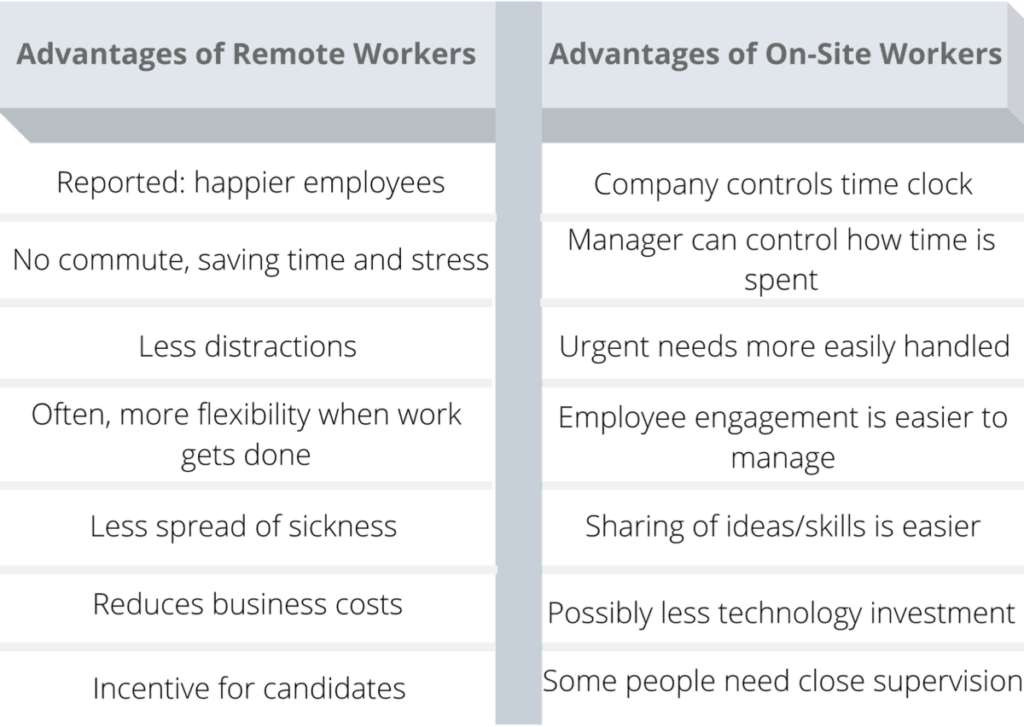There is more push from than ever before from employees who want to perform their job remotely. This means they want to work off of the company premises — from home or another alternate location.
So how do employers ensure remote workers are productive?
Successfully managing the productivity of remote employees requires that the manager be able to establish, communicate and measure clear deliverables to be provided by the remote employee, as well as manage the different interpersonal dynamics, and embrace the flexibility inherent in remote positions.
Specifically, to effectively manage remote employees, leaders need to:
- Establish clear deliverables
- Stay connected
- Treat employees as valued assets
- Embrace the benefit of flexibility
Let’s dive in a little deeper. Before getting into these 4 steps, let’s look at differences between office workers and remote workers.
Debate rages on regarding the true benefits of having a workforce that even partially works from home.
Debate: Productivity of Office Workers Versus Remote Workers
The debate about the effort, and ultimately the value of remote workers has been going on for years. But never before has the push by the workforce for remote opportunities been so strong.

Much of our modern-day tasks are performed through waves and wires: we conduct business by phone, by chat, through e-mail, and even video-conferencing that can be so clear it’s almost like sitting in the room right next to someone thousands of miles away. Yet, only a couple of decades ago, before email became widely used, corresponding was done on the phone or through the postal service.
The landscape has changed, and with it has changed the mix of jobs that are needed to support that landscape. The desire of the workers in these jobs to perform their jobs remotely has evolved, too.
These employees who conduct their jobs mostly over those waves and wires see no obstacles to performing their jobs anywhere.
There are advantages and disadvantages to working remotely. Below, let’s take a look at the advantages of remote and on-site workers side-by-side:

We’re going to break it down in more detail.
Advantages of having remote workers:
- Employees have absence of travel time, which can be a huge time-saver over a lifetime of working. If a remote worker keeps from spending 30 minutes to and from work each day for 40 years, they can save themselves 833 days! (That’s a little over 2 years!)
- Absence of traffic stress
- Less distractions: It is more difficult for employee to be pulled into other activities that may distract from tasks assigned.
“The office is actually an amazingly noisy environment. There’s a cake in the break room; Bob’s leaving, come join. The World Cup sweepstakes is going. Whatever it is, the office is super-distracting.”
Nicholas Bloom, Professor, Stanford Graduate School of Business (3)
- Flexibility and possibly more work performed: Because work must be more oriented towards deliverables, work can often be completed in evenings or weekends
- Reduced sickness spread through office (It is commonplace for sick employees to either not use their sick time, or much less “personal time off,” (aka, PTO) which lumps all time off into one bucket. Instead, employees will often go to the office sick, to avoid being penalized, getting others in the office infected. Remote working avoids this, which can lead to greater group productivity.
- Reduced business cost: One recent study suggests that in 2018, US businesses saved roughly $5 billion dollars by enabling employees to work remotely, at least part of the time. (4) This is shown through such things as reduced turnover (which saves cost in advertising for new associates, hiring, and training them), reduced office space (saves in real estate costs, utilities and incidentals like landscaping), and less office supplies sundries.
- Candidate incentive: One benefit that was glossed over above is worthy of mentioning again. That is that the ability to work remotely is looked at as either a benefit to the candidate market, or as some might say with millennials, a must. With the competitiveness of finding the best candidates to fill positions, the ability for hiring managers to entice workers through the ability to work remotely even part of the time could mean the difference between hiring the best candidate, or having that candidate decline and go elsewhere.
Advantages of having workers report to the office:
Company can control how time is spent: The boss can keep an eye on where employees are spending their time.
Manager can oversee time clock: The manager knows when people come and go.
Urgent changes can happen easily: The manager can quickly ask for a change in direction from tasks originally assigned
Involvement with everyone on the team is easier: Employee engagement might be easier and can be assessed by the manager more easily.
Sharing of ideas and skills happens more readily among everyone on the team.
Less investment (perceived or real) in technology; less need of additional technology to perform work as a team.
Those needing frequent direction can get it easily: Some people NEED constant direction; they don’t handle autonomy well and/or may not yet be adept at their job.
Remote Worker Statistics
- A survey conducted by Gallup showed that 37% of workers in 2015 stated that, at some point, they had telecommuted for their job. In 1995, that number was 9%. (1)
Some interesting statistics came from a survey conducted by TinyPulse in 2016: (2)
- A whopping 91% of the remote workers polled stated that they are more productive working remotely. They felt that being in the same physical proximity of their work group did not equate to greater productivity.
- In looking at remote workers’ responses in contrast to workers from any number of work arrangements, remote workers noted that they were happier, felt more valued, but didn’t have work relationships that were as strong.
- Happiest remote workers were those who work seven days per week with shorter work hours on all days; the next happiest group of remote workers worked sporadically throughout the work week, with the third-happiest group of remote workers being those who worked set hours, Monday through Friday from 9-5.
- Almost 50% of remote workers polled stated that they like to have communication from their manager at least once per day.
- A study conducted by Stanford Business professors showed that productivity improved 13% when employees were permitted to work remotely over those who worked in the office. The same study showed that turnover dropped 50%. The success of this study led the parent company to roll out a work-from-home alternative, which ultimately made them $2000 more in profit per employee working remotely. (2)
A Word About Remote Working and Employee Happiness
A study conducted in 2019 by OwlLabs, in conjunction with Global Workplace Analytics, involved over 1200 employees, with 62% working remotely full-time. They found that the ability to work remotely made employees:
- Happier, overall
- Feel They had a sense of balance between work and home life
- Have a sense they were more trusted and valued
- More apt to take a pay cut due to the benefits of remote working
- Of the total responses (38% of responses came from employees working on-site), the remote workers answered that they were happy with their jobs 22% more often than those working on-site.
How Managers Can Help Set Up Remote Workers for Success
- Establish clear deliverables: As we said at the beginning, establishing clear, measurable, timed and agreed-upon deliverables is key to the productivity of remote workers. Establish regular check-ins so that they become a normal way to mutually communicate. This enables the manager to gauge work flow, but also helps the employee feel connected.
- Stay connected: ensure involvement of remote workers with the team through regular one-on-one communication, team meetings, team building events and individual check-ins. Managers can prepare for the meetings by making sure all technology is working, and team discussion norms are established. (A common complaint about video and teleconference meetings is someone talking over another team member.) Also, the leader of a remote employee should understand that communication — seeking feedback, truly listening, and clearly expressing direction — is more important than ever.
- Treat them as valuable: This means empowering the employee to reach the deliverables without micromanaging. Recognize successes, both individually and to the group. Ask questions. Be inclusive.
- Embrace the value of flexibility (concentrate on the deliverables, and embrace the concept of the remote employee utilizing their time effectively, albeit during normal hours or otherwise.) This also means avoiding the impulse to constantly question if an employee is being productive because they can’t be immediately reached.
Will Remote Working Ever Be the Norm?
Opinions vary on this, and only time will tell. However, with more technologically-driven jobs, increases in costs of doing business, the stiff competition in hiring the best candidate, and the present employee base increasingly wanting remote opportunities, leaders within companies will certainly be pushed to consider the possibilities.
In order to have a successful outcome, a few key factors have to be present:
- The direct manager has to be able to clearly outline expected deliverables, and provide a realistic timeframe for accomplishing them
- The employee must understand and agree to the goals
- The employee must be able to commit a separate work space that will provide few distractions
- the direct manager must have the leadership style that will allow for the remote worker to be empowered to accomplish their required deliverables without a lot of direct involvement
- Both the manager and the employee must be open to communication of what is working and what needs adjusting
A Special Note:
There are many positions, particularly positions requiring discussions of sensitive/confidential information, that aren’t as suitable for employees who want to work off-site. Obviously, positions that include specific tasks necessitating the person be at a particular location would be excluded, as well.
Additionally, some managers, because of their need to control dynamics and manage individual tasks, will never be able to comfortably manage remote employees. Because of this, they’ll likely be the reason an employee isn’t afforded the opportunity to work off-site. Even worse, once someone is in a remote role, they may be the reason a person or the remote position is considered unsuccessful.
The manager must have th ability to strategize, set milestones, and get buy-in from the employee, along with their ability to handle the different interpersonal dynamics of a remote position.
So if a recent Forbes report is correct, which called remote work standard operating procedure for 50% of the US workforce, where might it leave the managers who just can’t seem to support having employees that work remotely?

